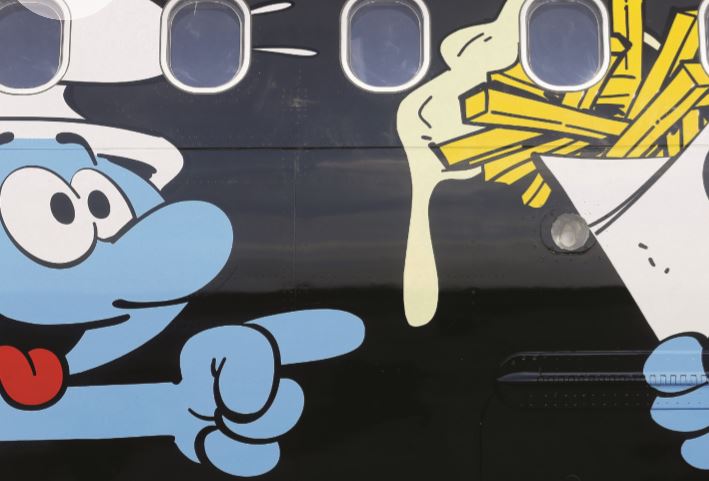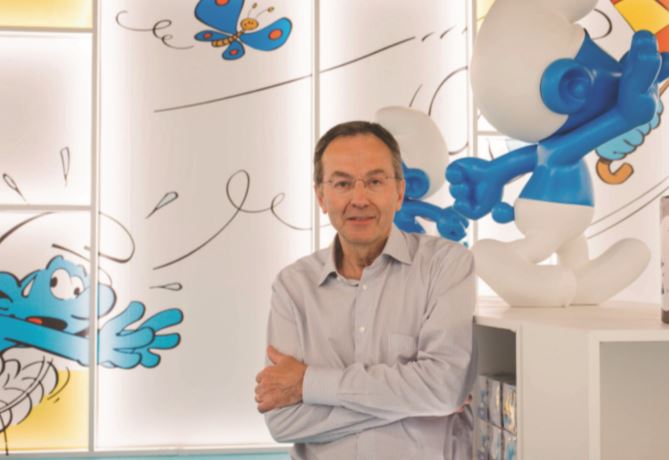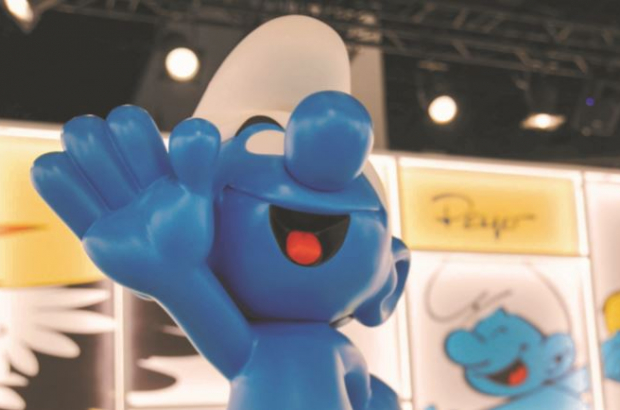- Daily & Weekly newsletters
- Buy & download The Bulletin
- Comment on our articles
True blue: Smurfs are everywhere as they celebrate 60th birthday
When cartoonist Pierre Culliford (aka Peyo) sketched his first Smurf, he could have had no idea that his creatures would one day be a household name around the world. But as a raft of major events, launches and exhibitions marking their diamond jubilee this year proves, the mini blue beings (“three apples high”) have spawned a mighty empire.
It all began on 23 October 1958, in Belgian comic-strip journal Spirou. In Peyo’s ongoing medieval series Johan and Peewit, a Smurf emerged from behind a rock after almost being stepped on. It was an inauspicious debut – but the public immediately took to the oddities, and soon they were the stars of their own show: first short stories, then comic books.
To keep up with public demand, Peyo created his own studio in 1964, in Uccle. Two decades later, his daughter Véronique launched IMPS, which manages all rights linked to the Smurfs, and has overseen their leap from the page to toothbrushes, T-shirts and theme parks – plus a Spanish village, Juzcar, painted blue. Today the 35-strong Smurf team, including an archivist and commercial department, is based in Genval, Walloon Brabant.
As the empire expands, however, the books remain key. “They’re less than 10% of the annual turnover, but for brand-building they’re the base of the pyramid,” says Fabienne Gilles, head of publishing at IMPS. “It’s important to us that the Smurfs aren’t just an image on a chewing gum packet. There has to be something behind it – values, joy – and kids discover that through the stories and TV series.”

The Smurfs’ transition to the screen, which was pivotal to their rise, dates to the 1980s, when American studio Hanna-Barbera created nine much-loved TV series (272 episodes) that are still broadcast around the world. Head to the Smurfs’ YouTube channel today and you can watch in 41 languages. The books have reached 90 territories and sold more than 35 million copies – with three films, produced by Sony Pictures, paving the way for further expansion (the first two grossed $1 billion worldwide).
The Chinese market is an area of particular growth, says Gilles, with IMPS recently partnering with new publishers across multiple categories. “Educative titles are something we really dig into,” she says. “We have Smurf comics with LingoZING!, an English-language app for non-natives. In Germany there’s a mathematics app, and in France a collection where you learn the school curriculum with Smurfs in a fun way. A really new thing we’ve started is bilingual English and simplified Chinese editions.”
Much like IMPS sends digital kits to theme park creators to mould Smurf figurines, publishing partners can use a style guide to make their own activity books. The comics, being more complicated to make (each takes a year to design), stay inhouse. The most recent, The Smurfs and the Dragon of the Lake, struck a nostalgic tone; other birthday spin-offs include six mini-stories first published in Spirou as cut-out-and-create folders, and a Peyo coffee-table book due in October.
It’s Smurchandise and promotions that dominate though, accounting for 75% of IMPS’s total revenue. According to merchandising head Tim Verschure, food and drinks are bestsellers – with 60,000 tons of Haribo Smurfs sweets sold every year. “We have around 700 active licensees and submit each one to certain qualifications,” he says. “Do they fit in with our vision? Do they comply with our goals? We need to ensure a quality level in our products.” Franchisees pay IMPS royalties from 3%-35%.
With 2018 declared Smurf Year by the Belgian government, the imps are running riot – showcased on the latest Brussels Airlines plane and on 55,000 commemorative stamp sets. In June, a Smurf mural was unveiled opposite Brussels Central station, with 101 Smurf paving stones leading to the Grand’Place, temporarily turning blue at nightfall (another mural is planned for Rochefort). And the Smurfs will serve as the mascots at September’s Comic Strip Festival in the capital.

But the showpiece event is the Smurf Experience, a huge exhibition at Brussels Expo. “It unfolds like a story. On entering, the public have the sensation that they’re getting smaller until they’re Smurfsized,” says Orphée Cataldo, co-founder of Charleroi’s Dirty Monitor, the company behind the show’s video segment, which spans holograms and motion-capture. A market-leader in the Belgian audiovisual sector, especially known for its 3D mapping and VJing expertise, Dirty Monitor started as an artist collective 12 years ago and has since worked on big launches at Dubai skyscraper Burj Khalifa, as well as an immense Bruegel projection in Montreal and an upcoming Alice in Wonderland-themed show in Seoul.
The Smurf Experience is one of their biggest projects to date, and not just physically. “There are bits using virtual reality – video feedback, or photo booths where visitors merge with the decor,” says Cataldo. “We needed a lot of people with different skills. We created all the scenery from the Smurfs’ world, and then reanimated models of all the characters.”
When Gargamel, the Smurfs’ foe, traps the public in a cage, the project uses 3D mapping, she explains. “Then there’s a moment where you return to the village on a stork’s back via a VR headset, and arrive and party with the Smurfs. It all ends well: you see yourself dancing, with the Smurfs teaching you the steps. It’s a paradise of new technologies.” Visitors enter through doors made up as comic-book pages. IMPS has high hopes for the show, and its in-house illustrators have been pivotal in creating the designs for the immense four-and-a-half-metre-high sets, which are animated by Dirty Monitor’s projections – like waterfalls running over pages.

The Smurfs have kept up with more than just technology: August sees the release of the second girl Smurfs book – a major turnaround (the “Smurfette principle”, nodding to the group’s sappy heroine, is used to describe productions with a lone female in the cast). “We think she’s a bit too conventional,” admits Gilles. “Society is more gender-neutral now and we’re trying to go in that direction too.”
Initially introduced in tandem with 2017 film Smurfs: The Lost Village, about the discovery of a new girl-only village where women rule the roost, oblivious to men, the female spin-off has already provided a fruitful new avenue for IMPS. “The first edition of The Smurfs and the Girls’ Village was really welcomed by the public and new audiences – maybe more girls bought it, or fans of the movie,” says Gilles. But it’s not all change. “Smurfette will always be Smurfette,” she says.

Back to the drawing board
Veteran cartoonist Jeroen de Coninck is a leading illustrator at IMPS
How long have you illustrated the Smurfs?
I came to the studio in 1990, when I was 36. In the beginning I didn’t know the Smurfs that well, I was too old, and hadn’t seen them on TV, although I knew Peyo’s albums. I thought: The Smurfs? I’ll last two years. Since then I’ve probably drawn 10,000 Smurfs. It’s impossible to count.
What was it like working with Peyo?
Peyo would take my drawings away and the next day he’d come to the studio with tracing paper covered in corrections. You had to tell your story clearly so people could immediately tell what it was, but it couldn’t be simple either. Once he took us to the forest and made us lie down to see the world from a Smurf’s perspective. But it didn’t really work!
Why do you think they’re so popular?
You can explain many things to children through Smurfs and they think about it and draw their own conclusion. There’s a Smurf policeman story where children learn not to act immediately. It’s more fun than saying, you must do this or that. Everyone can empathise with a Smurf too.

Staging the Smurfs
Stephan Uhoda is the CEO of Liège- and Brussels-based events and communication company Cecoforma, which produced the Smurf Experience.
How did the Smurf Experience come about?
IMPS came up with the idea of a special event for the 60th anniversary of the Smurfs, and Cecoforma obtained a licence agreement for the project. We’re responsible for all aspects of it: concept creation, artistic direction and staging the event in Brussels and abroad.
What were the biggest challenges?
The Smurfs are recognised around the world, and so much has already been produced based on their universe. We had to create something innovative and surprising while conserving the identity of the Smurfs, and appealing to children and parents alike. Another challenge was the size: larger-than-life sets filling 1,500 square metres – and the fact that this is going to travel the world for five years, so has to be really resistant.
How big is this project for Cecoforma?
We manage about 250 events a year and have worked in more than 100 countries. For the show we raised €5 million through public funds – including the tax-shelter scheme for living arts projects – and private investment. We’re expecting around 250,000 visitors.
This article first appeared in WAB (Wallonia and Brussels) magazine



















